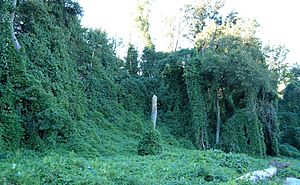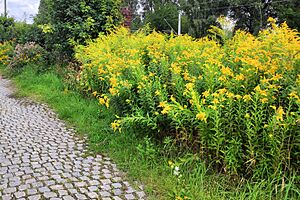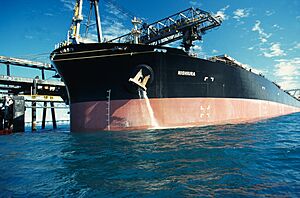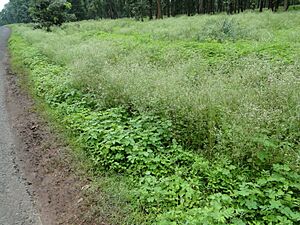Invasive species facts for kids
An invasive species is a type of introduced species that causes harm to its new environment. These species can negatively affect habitats and natural areas, leading to ecological, environmental, or economic problems. Sometimes, even native species can become harmful if human changes to their food web make them too powerful. Since the 1900s, invasive species have become a major threat around the world.
It's natural for organisms to spread into new areas, but humans have greatly sped up this process. For thousands of years, people have accidentally or purposely moved species, starting with early human travels and increasing with global trade. Some well-known invasive plants include the kudzu vine, giant hogweed (Heracleum mantegazzianum), Japanese knotweed (Reynoutria japonica), and yellow starthistle (Centaurea solstitialis). Famous invasive animals include European rabbits (Oryctolagus cuniculus), domestic cats (Felis catus), and carp (family Cyprinidae).
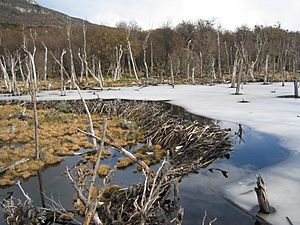

Contents
What Are Invasive Species?
Invasive species are a specific group of non-native species that threaten native plants, animals, and the overall variety of life (biodiversity). The word "invasive" can be a bit confusing and often depends on who is using it. Invasive species can be plants, animals, fungi, or tiny microbes. Some people even include native species that have taken over human-made areas like farms.
Scientists who study invasive species often work in ecology (how living things interact with their environment) and biogeography (where living things are found). A famous book from 1958, The Ecology of Invasion by Animals and Plants by Charles Sutherland Elton, helped shape this field.
How Do Species Become Invasive?
For an introduced species to become invasive, it usually needs to survive when there are only a few of them in a new place. It can be hard for a species to reproduce and grow in a new area at first. So, a species might need to arrive many times before it can truly settle down. Human activities, like ships traveling between ports or cars on highways, offer many chances for species to be introduced repeatedly.
Ecosystem Changes
In ecosystems, the amount of available resources affects how new species impact the environment. Healthy ecosystems have a balance of resources. Invasive species can upset this balance. For example, after a forest fire, native grasses and forbs usually grow back. But an introduced species that spreads faster can take over, outcompeting native plants for food and space.
Every species has a special role, or ecological niche, in its native ecosystem. Some species have many roles, while others are very specialized. Invading species might fill empty roles or even create new ones. For instance, when land is cleared for farming, the edge between the wild habitat and the cleared land creates a new environment. This new edge can help certain species thrive that wouldn't normally do well in the undisturbed habitat.

Island ecosystems are often more easily invaded. This is because island species usually have fewer strong competitors and predators. Also, being far from other populations means islands might have "open" roles for new species to fill. For example, native birds on Guam have been greatly harmed by the invasive brown tree snake (Boiga irregularis).
In New Zealand, the first invasive species were dogs and rats brought by Polynesian settlers around 1300. These and other introductions caused huge damage to New Zealand's unique species. The colonization of Madagascar also harmed its ecosystems.
Invasive plants can also change the land itself. For example, kudzu (Pueraria montana), a vine from Asia, was brought to the southeastern United States in the early 1900s to stop soil erosion. Invasive animals can also change the land by digging or building. The Chinese mitten crab (Eriocheir sinensis) can increase digging and erosion rates.
Sometimes, a native species can become harmful if humans change its food web. This happened with the purple sea urchin (Strongylocentrotus purpuratus) off northern California. It destroyed kelp forests because its natural predator, the California sea otter (Enhydra lutris), was overhunted.
Species Traits and Adaptations

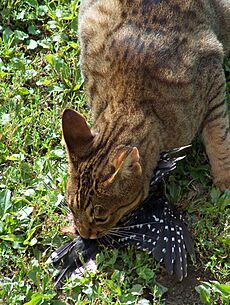
Invasive species often have special traits that help them outcompete native species. These traits can include growing and reproducing very quickly. For plants, this might mean spreading easily through vegetative reproduction. Many invasive species are also linked to humans or have been successful invaders in other places before. Domestic cats (Felis catus) are very good hunters and have become wild and invasive in places like the Florida Keys.
An introduced species might become invasive if it can take resources better than native species. If these species developed where there was a lot of competition or predation, then the new environment might have fewer strong competitors, allowing the invader to grow rapidly.

An invasive species might also use resources that native species can't, like deep water accessed by a long taproot, or live in soil types that were previously empty. For example, barbed goatgrass (Aegilops triuncialis) was introduced to California on serpentine soils, which are tough for plants. But goatgrass can grow thickly there and push out native species.
Invasive species can also change their environment by releasing chemicals, changing non-living factors like soil, or affecting how plant-eating animals behave. Some, like mother of thousands (Kalanchoe daigremontana), produce chemicals that stop other plants from growing. Others, like the toad plant (Stapelia gigantea), help other seedlings grow in dry areas by providing shade and protecting them from animals.
Changes in fire regimes are another way invaders help themselves. Cheatgrass (Bromus tectorum), from Eurasia, loves fire. It spreads quickly after a fire and makes fires happen more often and burn hotter. This changes the local fire pattern so much that native plants can't survive, allowing cheatgrass to take over.
Introduced species can spread quickly and in unexpected ways. Even if a small group starts, they can adapt very fast. This quick adaptation helps them survive new challenges like different temperatures or new predators.
The enemy release hypothesis suggests that in every ecosystem, there's a balance. No single species can take over because of competitors, predators, and diseases. But when an introduced species moves to a new place, it might become invasive and grow rapidly if these natural controls are missing.
How Invasive Species Spread
Most non-native species are spread by human activity. While species naturally expand their range, humans often carry them much faster and farther than nature would. An early example is when prehistoric humans brought the Pacific rat (Rattus exulans) to Polynesia.
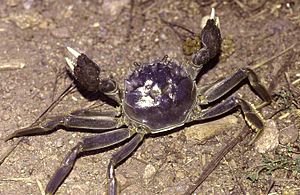
Ways species are spread include plants or seeds brought in for horticulture (gardening). The pet trade moves animals across borders, and these animals can escape and become invasive. Organisms can also hide on transport vehicles. Accidental human transfer is the main reason for introductions, except in very cold polar regions. Diseases can also be carried by invasive insects. For example, the Asian citrus psyllid (Diaphorina citri) carries a bacterial disease called citrus greening.
Sometimes, once invasive species take over an area, they become a key part of that ecosystem. Removing them could cause more harm. Money also plays a role in introducing exotic species. High demand for the valuable Chinese mitten crab might explain why it was possibly released on purpose in foreign waters.
Spreading in Water
Shipping has greatly changed how marine organisms travel. New ways species spread include attaching to ship hulls and being carried in ballast water. In fact, studies show that shipping is the main way marine invasive species are moved around.
Many marine organisms can stick to ship hulls. These organisms are easily moved from one body of water to another, posing a big risk for biological invasions. Controlling hull fouling is often voluntary, but some governments, like California and New Zealand, are making stricter rules.
Another way aquatic species spread is through ballast water. Ships take in ballast water at sea and release it in port. About 10,000 species are transported this way every day. Many of these are harmful. For example, freshwater zebra mussels (Dreissena polymorpha) from Eurasia likely reached the Great Lakes via ballast water. These mussels compete with native organisms for oxygen and food. They can even be transported in small puddles left in supposedly empty ballast tanks. Rules try to reduce these risks, but they are not always successful.
Climate change is causing ocean temperatures to rise. These changes make organisms move to new areas, creating new interactions between species. For example, organisms in a ship's ballast tank traveling from a cool zone through tropical waters might experience big temperature changes. Surviving these heat challenges during transport can make species more tolerant to stress in their new non-native range, helping them survive increased ocean temperatures.
Wildfires and Firefighting
Invasive species often take advantage of disturbances to an ecosystem, like wildfires, roads, or foot trails, to move into an area. Large wildfires can make soils sterile but also add nutrients. Invasive plants that can regrow from their roots then have an advantage over native plants that rely on seeds.
Negative Effects of Invasive Species
Invasive species can harm the places they invade, causing problems for the environment, nature, or the economy.
Ecological Harm
The European Union defines "Invasive Alien Species" as those outside their natural area that threaten biological diversity. Biological invasion is one of the top five reasons for global biodiversity loss, and it's increasing due to tourism and globalization. This is especially true in poorly regulated fresh water systems, though rules for quarantines and ballast water have helped.
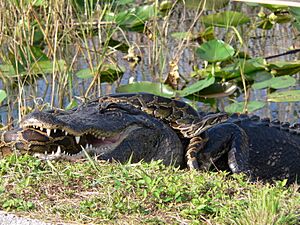
Invasive species can cause local native species to disappear. They might outcompete native species for resources, take over their roles, or even breed with related native species. This can lead to big changes in the types of plants and animals in an area, eventually making the world's wildlife more similar everywhere and causing a loss of biodiversity. It's hard to say for sure that an invasion caused an extinction, but there's strong evidence that a fungus spread by international trade caused the extinction of about 90 amphibian species.
Multiple introductions of different non-native species can make the total effect worse. For example, in California's Bodega Harbor, the amethyst gem clam (Gemma gemma) was introduced a century ago. It didn't displace native clams on its own. But in the mid-1990s, the introduction of the European green crab led to an increase in the amethyst gem clam and a decrease in native clams.
Invasive species can change how ecosystems work. For example, invasive plants can alter fire regimes (cheatgrass, Bromus tectorum), nutrient cycling (smooth cordgrass, Spartina alterniflora), and water flow (Tamarix) in native ecosystems. Invasive species closely related to rare native species can breed with them. This can harm and even lead to the extinction of native species. For example, breeding with introduced cordgrass threatens the California cordgrass (Spartina foliosa) in San Francisco Bay. Because of competition from invasive species, 400 of the 958 endangered species under the Endangered Species Act are at risk.

The accidental introduction of forest pests and plant diseases can change forest ecology and harm the timber industry. Many U.S. forest ecosystems are widely invaded by exotic pests, plants, and diseases.
The Asian long-horned beetle (Anoplophora glabripennis) was first found in the U.S. in 1996. It was expected to damage millions of acres of hardwood trees. By 2005, millions of dollars had been spent trying to get rid of this pest. The woolly adelgid (Adelges tsugae) has damaged old-growth spruce, fir, and hemlock forests and harms the Christmas tree industry. Chestnut blight (Cryphonectria parasitica) and Dutch elm disease (Ascomycota) are plant diseases with serious impacts. Garlic mustard (Alliaria petiolata) is a major invasive plant in eastern North American forests. It takes over the understory, slowing the growth of tree seedlings and threatening to change the types of trees in the forest.
Native species can be threatened with extinction through genetic pollution. This happens when introduced species accidentally breed with native ones, leading to a mix of genes that can make local populations less fit or even replace them. Invasive species have been shown to adapt to their new environments very quickly. Their population might stay small for years and then suddenly explode, a phenomenon called "the lag effect."
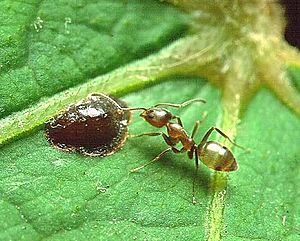
Hybrids (offspring of two different species) from invasive species breeding with native species can introduce their genes into the native gene pool over time. Even a small invading population can threaten much larger native populations. For example, cordgrass (Spartina alterniflora) was introduced in San Francisco Bay and bred with native California cordgrass (Spartina foliosa). The invasive species' pollen was more successful, threatening the native populations.
Environmental Harm
In South Africa's Cape Town region, removing thirsty invasive plants (like Australian acacias, pines, eucalyptus, and Australian black wattle) from water source areas could increase annual water gains by 50 billion liters within 5 years. This is like one-sixth of the city's current water needs. These gains are expected to double within 30 years. Restoring these areas is much cheaper than other ways to get more water. A water fund has been set up, and these exotic species are being removed.
Human Health Impacts
Invasive species can affect human health. By changing how ecosystems work, they can reduce available resources, allow human diseases to spread unchecked, and impact recreational activities and tourism. Introduced birds (e.g., pigeons), rodents, and insects (e.g., mosquito, flea, louse and tsetse fly pests) can carry and spread human illnesses. Throughout history, epidemics of human diseases have spread through these carriers. A recent example is the spread of the West Nile virus, which has killed humans, birds, mammals, and reptiles. The introduced Chinese mitten crabs (Eriocheir sinensis) can carry Asian lung fluke. Waterborne disease agents, like certain bacteria, and causes of harmful algal blooms are often carried in ballast water.
Economic Costs
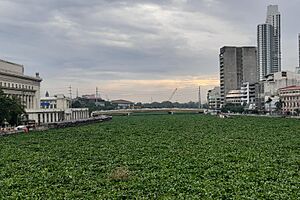
Globally, managing and controlling invasive species costs a lot of money, reaching about $1.4 trillion each year. The economic impact of invasive alien species alone was estimated to be over $423 billion annually as of 2019. This cost has grown a lot, quadrupling every ten years since 1970, showing how expensive these biological invasions are becoming.
Invasive species cause environmental damage, changing how ecosystems work and reducing the benefits they provide. This means more money has to be spent to control their spread, reduce further harm, and restore affected ecosystems. For example, the damage caused by 79 invasive species in the United States between 1906 and 1991 was estimated at US$120 billion. In China, invasive species have been reported to reduce the country's economic output by 1.36% per year.
Managing biological invasions can be very expensive. In Australia, for instance, the cost to monitor, control, manage, and research invasive weed species is about AU$116.4 million per year for governments alone.
While some invasive species might offer economic benefits, like potential for commercial logging from invasive trees, these benefits are usually much smaller than the huge costs they create. In most cases, the money gained from invasive species is far less than the problems they cause.
Costs in the United States
In the Great Lakes region, the sea lamprey (Petromyzon marinus) is an invasive species. In its original home, it was a parasite that didn't kill its host. But in the Great Lakes, it acts as a predator and can eat up to 40 pounds of fish in its 12–18 month feeding period. Sea lampreys prey on large fish like lake trout (Salvelinus namaycush) and salmon. Their destructive effects on large fish harm the fishing industry and have caused some fish populations to collapse.
Economic costs from invasive species include direct costs from lost production in farming and forestry, and management costs. Estimated damage and control costs of invasive species in the U.S. are more than $138 billion annually. Money is also lost from recreational and tourism activities. If we put a money value on the extinction of species, loss of biodiversity, and loss of ecosystem services, the costs from invasive species would increase greatly. Experts often say that the key to managing invasive species is to find them early and respond quickly. However, early response only helps if the invasive species isn't often reintroduced, and if the cost of the response is affordable.
Weeds reduce crop yields in agriculture. Many weeds are accidentally introduced with commercial seeds and plants. Introduced weeds in pastures compete with native forage plants, threaten young cattle, or are unpleasant to eat because of thorns (e.g., yellow starthistle, Centaurea solstitialis). Lost forage from invasive weeds on pastures costs nearly US$1 billion in the U.S. A decline in pollinator services and fruit production has been caused by honey bees (Apis mellifera) infected by the invasive varroa mite (Varroa destructor). Introduced rats (Rattus rattus and R. norvegicus) have become serious pests on farms, destroying stored grains. The introduction of leaf miner flies (Agromyzidae), including the American serpentine leaf miner (Liriomyza trifolii), to California has caused losses in California's floriculture industry, as their larvae feed on ornamental plants.
Invasive plant diseases and insects that carry plant diseases can reduce farm yields and harm nursery plants. Citrus greening is a bacterial disease carried by the invasive Asian citrus psyllid (Diaphorina citri). As a result, citrus is under strict rules in areas where the psyllid has been found.
Invasive species can impact outdoor fun like fishing, hunting, hiking, wildlife viewing, and water activities. They can damage environmental services including water quality, plant and animal diversity, and the number of species. For example, Eurasian watermilfoil (Myriophyllum spicatum) in parts of the US fills lakes with plants, making fishing and boating difficult. The loud call of the introduced common coqui (Eleutherodactylus coqui) lowers real estate values in affected neighborhoods of Hawaii. The large webs of the orb-weaving spider (Zygiella x-notata), invasive in California, make garden work harder.
Costs in Europe
The total economic cost of invasive alien species in Europe between 1960 and 2020 has been estimated at around US$140 billion. This is a very careful estimate. Models suggest the true annual cost was around US$140 billion in 2020.
Italy is one of the most invaded countries in Europe, with over 3,000 alien species. The economic impacts have been wide-ranging, from management costs to crop losses and damage to buildings. The total economic cost of invasions to Italy between 1990 and 2020 was estimated at US$819.76 million. However, only 15 species have more reliable cost estimates, so the actual cost is likely much higher.
France has at least 2,750 introduced and invasive alien species. A study found that they caused a total cost between US$1.2 billion and 11.5 billion from 1993–2018. Damage costs were nearly eight times higher than management spending. Insects, especially the Asian tiger mosquito (Aedes albopictus) and the yellow fever mosquito (A. aegypti), caused the highest economic costs. Over 90% of alien species in France had no costs reported in studies, but this doesn't mean they have no negative effects or costs.
Positive Effects of Invasive Species
Some scientists, like entomologist Chris D. Thomas, argue that most introduced species are neutral or even helpful to other species. However, most scientists agree that their effects on biodiversity are negative.
Some invasive species can provide good habitat or food for other organisms. In areas where a native species has disappeared or can't be brought back, non-native species can fill their role. For example, in the US, the endangered southwestern willow flycatcher (Empidonax traillii) mostly nests in the non-native tamarisk plant. The introduced mesquite (Neltuma juliflora) is an aggressive invasive species in India, but native waterbirds in cities like Udaipur prefer it for nesting. Similarly, Ridgway's rail (Rallus obsoletus) has adapted to an invasive hybrid plant, which offers better cover and nesting spots. In Australia, saltwater crocodiles (Crocodylus porosus), which were endangered, have recovered by eating introduced feral pigs (Sus domesticus).
Non-native species can also help with restoration, increasing the variety and biodiversity in an ecosystem. They can create small climates in sparse and eroded areas, helping native species grow back. For example, in Kenya, guava trees in farmland attract many fruit-eating birds. These birds drop seeds from rainforest trees up to 2 kilometers away under the guava trees, helping the forest regrow.
Non-native species can provide ecosystem services, like acting as biocontrol agents to limit invasive farm pests. Asian oysters, for example, filter water pollutants better than native oysters in Chesapeake Bay. Some species have been in an area for so long that they are considered to have become naturalised. For example, the sweat bee (Lasioglossum leucozonium), an invasive species in North America, has become an important pollinator for caneberry (Rubus spp.) as well as cucurbit, apple trees, and blueberry (Cyanococcus) bushes. In the US, the endangered Taylor's checkerspot butterfly (Euphydryas editha taylori) now relies on invasive ribwort plantain (Plantago lanceolata) as food for its caterpillars.
Some invasions offer potential business benefits. For instance, silver carp (Hypophthalmichthys molitrix) and common carp (Cyprinus carpio) can be caught for human food and exported, or processed into pet foods. Water hyacinth (Pontederia crassipes) can be turned into fuel, and other invasive plants can be used as a source of bioenergy.
Controlling Invasive Species
Humans are capable of fixing the problems caused by species invasions. People are often motivated to help when invasive species affect their local area. Controlling alien species populations is important for protecting biodiversity in natural ecosystems. One promising method for control is using genetics.
Cargo Inspection and Quarantine
The main reason for inspecting cargo was to protect against agricultural pests while still allowing farm products to be exported. In 1994, the first global standards were agreed upon, including the Agreement on the Application of Sanitary and Phytosanitary Measures (SPS Agreement). These are overseen by the World Trade Organization. The International Maritime Organization oversees the International Convention for the Control and Management of Ships' Ballast Water and Sediments (the Ballast Water Management Convention). The Convention on Biological Diversity also includes steps its members should take to control invasive species.
Slowing the Spread
Firefighters are now responsible for cleaning their own equipment, public water equipment, and private water equipment. This is because of the risk of spreading aquatic invasive species. In the United States, this is especially a concern for wildland firefighters because quagga (Dreissena bugensis) and zebra (Dreissena polymorpha) mussel invasions and wildfires often happen in the American West.
Reestablishing Native Species

Island restoration involves getting rid of invasive species on islands. A 2019 study suggested that if invasive animals were removed from just 169 islands, the survival chances of 9.4% of the Earth's most threatened island animals would improve.
Removing invasive animals from islands helps achieve United Nations Sustainable Development Goal 15, which focuses on life on land.
Rodents were brought to South Georgia, an island in the southern Atlantic Ocean with no permanent residents, in the 1700s by ships. They quickly harmed the island's bird population, eating eggs and attacking chicks. In 2018, South Georgia Island was declared free of invasive rodents after a multi-year effort. Bird populations have recovered, including the South Georgia pipit (Anthus antarcticus) and South Georgia pintail (Anas georgica georgica), both unique to the island.
Replacing Extinct Species
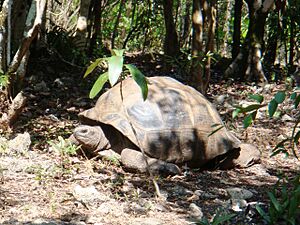
Non-native species can be introduced to fill a role that was previously done by a native species that is now extinct. This is called taxon substitution. On many islands, the extinction of tortoises led to ecosystems where seeds weren't spread and plants weren't eaten properly. On small islands off Mauritius, tortoises that are now extinct were key plant-eaters. Introducing the non-native Aldabra giant tortoises (Aldabrachelys gigantea) on two islets in 2000 and 2007 has started to restore the natural balance. The introduced tortoises are spreading seeds of native plants and selectively eating invasive plant species. Their grazing is expected to replace ongoing manual weeding, and the introduced tortoises are already breeding.
Eating Invasive Species
The idea of eating invasive species to reduce their populations has been explored. In 2005, Chef Bun Lai of Miya's Sushi in New Haven, Connecticut created the first menu dedicated to invasive species. By 2013, Miya's offered invasive aquatic species like Chesapeake blue catfish (Ictalurus furcatus), Florida lionfish (Pterois sp.), Kentucky silver carp (Hypophthalmichthys molitrix), Georgia cannonball jellyfish (Stomolophus meleagris), and invasive plants like Japanese knotweed (Reynoutria japonica) and autumn olive (Elaeagnus umbellata). Joe Roman, a conservation biologist, runs a website called "Eat The Invaders." Organizations have published cookbooks and recipes using invasive species. Invasive plants have also been looked at as a source of healthy chemicals and edible protein.
Supporters of eating invasive organisms argue that humans can eat away any species they have an appetite for, pointing to animals humans have hunted to extinction, like the Caribbean monk seal (Neomonachus tropicalis) and the passenger pigeon (Ectopistes migratorius). They also point to how Jamaica successfully reduced the lionfish population by encouraging people to eat the fish. Skeptics say that once a foreign species is well-established in a new place, like the Indo-Pacific lionfish that has taken over waters in the Western Atlantic, Caribbean, and Gulf of Mexico, getting rid of it is almost impossible. Critics also worry that encouraging consumption might accidentally spread harmful species even more widely.
Pesticides and Herbicides
Pesticides are often used to control invasive species. Herbicides used against invasive plants include those made from fungi. Even though an introduced population might start small, some genetic variation can give invasive plants resistance against these fungal bioherbicides. For example, invasive populations of cheatgrass (Bromus tectorum) have developed resistance to a biocontrol fungus.
Gene Drive Technology
A gene drive could be used to eliminate invasive species. For example, it has been suggested as a way to eliminate invasive mammal species in New Zealand. Normally, an individual gets two versions of a gene, one from each parent, with a 50:50 chance of inheriting either. Genetic engineering can be used to make sure a desired gene is inherited more often, leading to its faster spread in future generations. Gene drives are being explored for biodiversity conservation, especially for invasive rodents, because they might pose less risk to non-target species and cost less than traditional removal methods. Some scientists are concerned that this technique could wipe out species in their original native habitats, or that the gene could change and cause unexpected problems.
Predicting Invasive Plants
Accurately predicting the impacts of non-native plants can be a very effective management option because most non-native plant species are introduced on purpose. "Weed risk assessments" try to predict the chances that a specific plant will have negative effects in a new environment, often using a standard questionnaire. The total score from these assessments is linked to a management action, such as "prevent introduction." These assessments commonly use information about the plant's body, life cycle, native areas, and family relationships. The effectiveness of this approach is still debated.
Returning Invasive Species to Their Origin
In 2025, for the first time, a project began in the Hebrides in Scotland to return an invasive species to its country of origin. Hedgehogs, native to the UK mainland, were brought to these islands decades ago to fight garden pests. However, their introduction severely harmed ground-nesting birds. The authorities decided to move the hedgehogs back to the mainland, helping the birds without harming the hedgehogs.
See also
 In Spanish: Especie invasora para niños
In Spanish: Especie invasora para niños
- Lists of invasive species
- 100 of the World's Worst Invasive Alien Species


